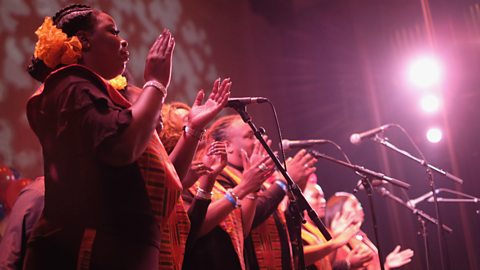Worship
Liturgical and non-liturgical worship
The key difference in how Christian worship is approached is whether it is defined as liturgical worshipA church service which follows a set structure or ritual. or non-liturgical worshipA church service which does not follow a set text or ritual. This type of worship is often called 'spontaneous' or 'charismatic' in nature..
Liturgical worship
Liturgical worship involves worshipping in a public setting, generally during a church service. In liturgical worship, Christians use a service book and set prayerCommunication with God. A means of developing a personal relationship with God., which means that everyone worships in the same way. There are specific moments in the worship when everyone joins in.
Bible readings are often used during services. In many churches, these readings are scheduled a year in advance, in a list format known as a lectionary.
These follow the liturgical year and are completed in a three-year cycle. This enables regular churchgoers to hear the majority of the Bible read aloud.

Non-liturgical worship
Non-liturgical worship is performed publicly and does not include set prayers or follow a set schedule. The leader of the worship is often a priest but may also be a member of the congregationA group of people who assemble for religious worship.. This leader chooses the prayers and readings.
The sermonReligious teaching usually given verbally to a group of believers. focuses on a theme chosen by the leader and may reflect important issues the community is facing. Prayers do not follow a set format. Music is important in non-liturgical worship, and often hymns or Gospel songs are performed.

Informal worship can be performed outside a church setting, often at home. For example, families may say grace together before eating, or read the Bible together. Informal worship may also take place at church, but in a more relaxed setting than a church service. Some families may take their young children to ‘messy church’, where there is the opportunity for play alongside prayer.
Individual worship is worship done in private. This may involve an individual praying to God and reflecting on their relationship with God.
Book of Common Prayer
The Book of Common Prayer was introduced by the AnglicanAn adjective describing the Church of England or a member of the Church of England. Church in 1549 and is widely used in ProtestantChristians who broke away from the Roman Catholic Church during the Reformation. They believe in the teachings of the Bible but reject the authority of the Pope. church services. It helps the leaders of the worship to use prayers that are appropriate to each service. It is viewed as being very special, as it is written in a distinctive and poetic style that draws on the language of Shakespeare.
Different Christian attitudes towards worship
- CatholicA group of Christians who accept the Pope in Rome as their leader. and Anglican churches generally prefer liturgical worship because following a set format helps worship to become a repeated ritual with a clear place in people’s lives. Praying in this way connects worshippers to the rest of the Church as everyone says and does the same things. This creates a sense of belonging.
- PentecostalA Church that emphasises certain gifts, eg healing the sick, which were granted to the first believers on the Day of Pentecost. churches prefer non-liturgical worship because it is freer and more flexible. This allows people to participate in a way that feels right to them and that reflects their mood.